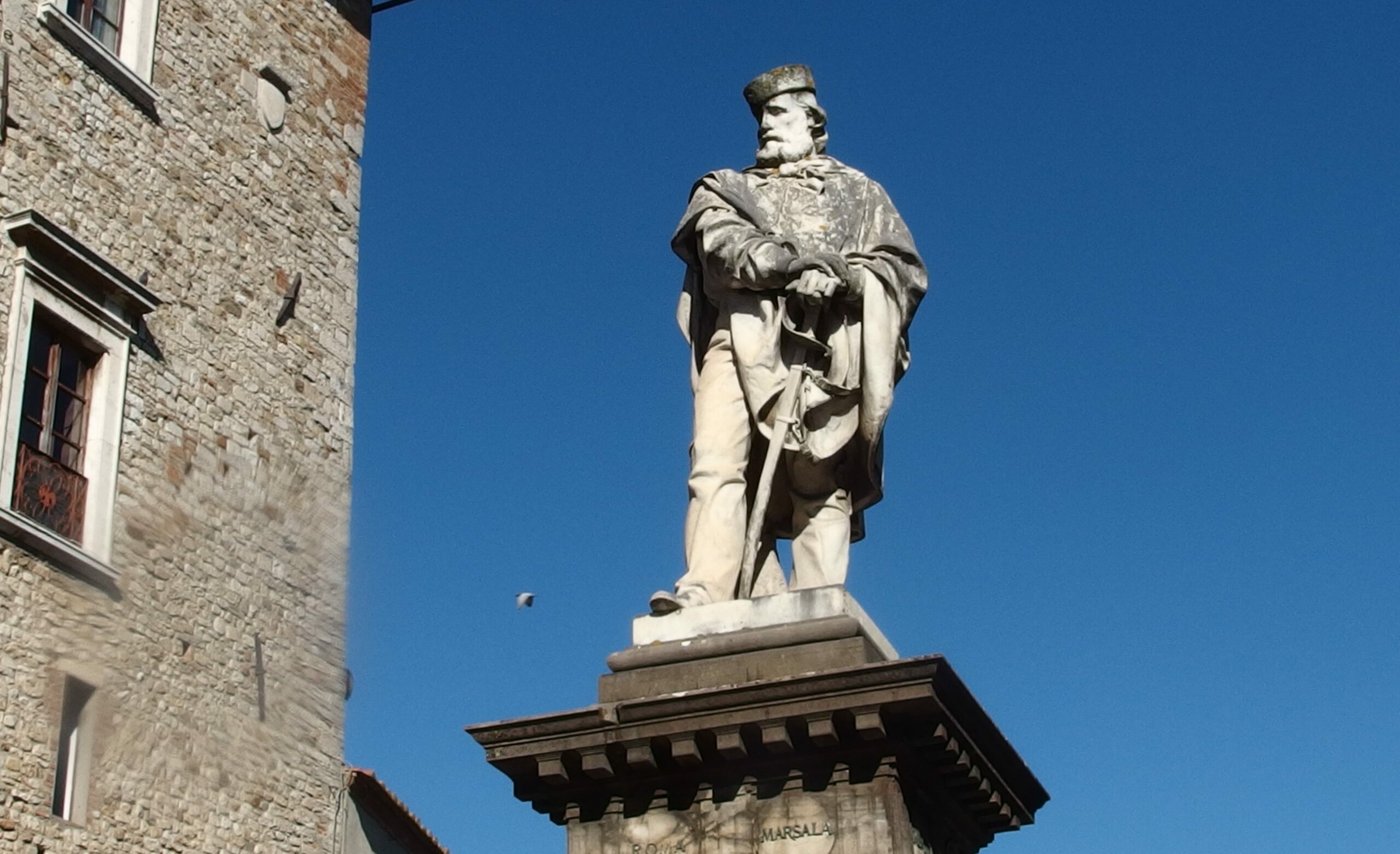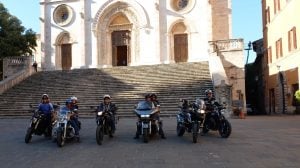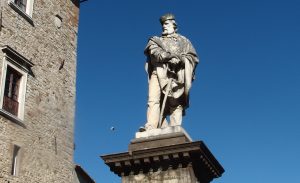Everyone in Italy parks scooters and motorbikes chockablock. No matter how much chrome or how many farkles a bike is adorned with, I never saw an incident of I’m-too-special-and-my-bike’s-too-precious-to-share-a-parking-space behavior. If there is enough space to mount and dismount, that’s sufficient; share the space.
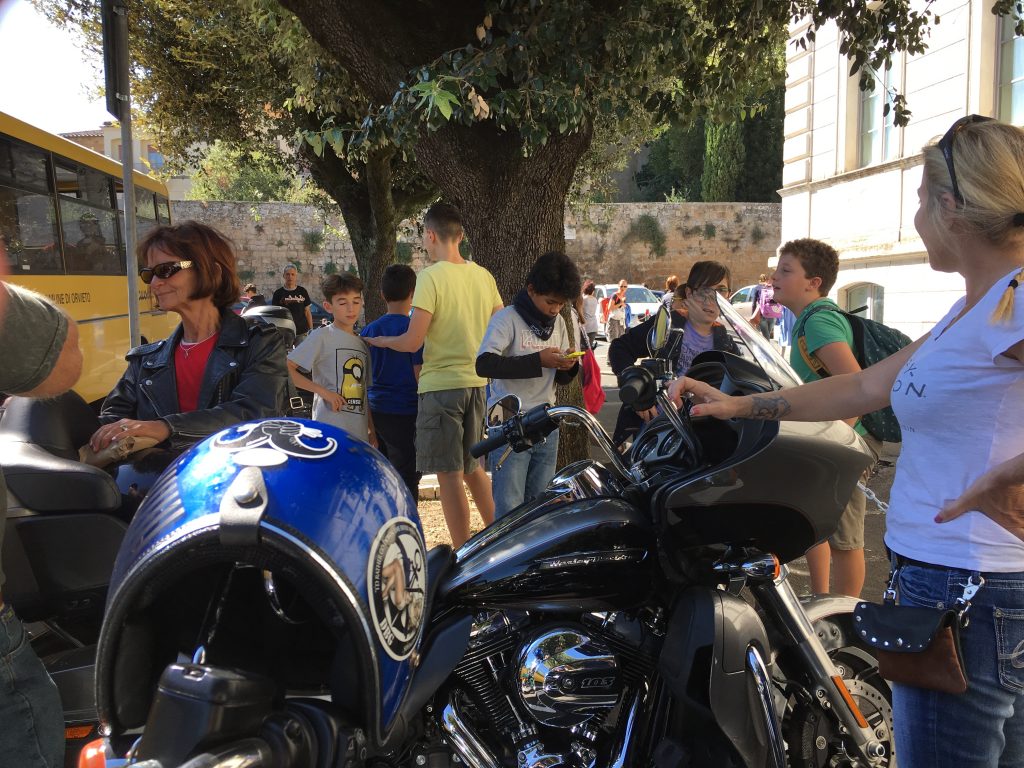
Orvieto school children
Our Orvieto parking lot is right beside a school, and as we prepare for our afternoon ride through Umbria, we are fortunate to witness school letting out for the afternoon. A fair number of pre-teens climb onto school buses while the others mill around in groups looking at their phones, flirting, and waiting for a parent to pick them up or walk them home. While we wait I ask our guide Enrico about the public school system in Italy.
Italy’s education system
Until middle school, the core educational curriculum is the same for all pupils, no matter whether they go to a private or state-funded school. Kids in state schools tend to outperform those in private. In 2013, Italy’s secondary education was ranked as the 21st in the world, above the United States and the OECD average.
By the time students reach what Americans call high school, Italian students follow in one of three paths:
- Liceo (lyceum), which equates to what we call “the liberal arts”
- Istituto tecnico (technical institute), which prepares students for careers in everything from humanities, administration, and law, to technology and tourism
- Istituto professionale (professional institute), which teaches practical subjects like engineering, agriculture, gastronomy, technical assistance, and handicrafts. This program enables students to start a job as soon as they finish, which could be between 3-5 years.
Students who attend any of these programs for five years and earn a diploma are eligible to sit for a university entrance exam.
Enrico tells me that he specialized in agriculture at instituto professionale and then everything about his knowledge and passion for food and culture locks into place for me. No wonder he knows the type of soil where broccoletti thrives, and the herbs that goats eat which in turn gives pecorino cheese its distinctive taste.
If you’ll give me a moment to opine, there are merits to the Italian system over the American, not only in student performance. I also see benefits to a society whose youth are equipped to start real careers without crushing student debt acquired in excessive years of university over that which is truly required to do a job. As the mother of two millennials I know of what I speak. Americans indiscriminately preach “university, university, university” to kids from elementary school on up, despite underemployment for recent college grads. I’ll step off my soapbox now.
La Strada delle Mille Curve (“road of a thousand curves”)
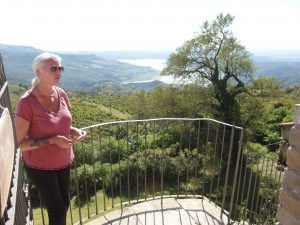
Christin overlooking Lake Corbara
After the buses pull away from our little parking lot we mount up. Leaving Orvieto, we ride what Italian motorcyclists call La Strada delle Mille Curve (“road of a thousand curves”) toward Todi. The Italian claim of a thousand curves here is no more hyperbolical than boasting 318 curves in 11 miles—looking at you, Tail of the Dragon—but I enjoyed La Strada delle Mille Curve much more.
We are now touring the scenic roads that circle Lake Corbara. Created by a 701-yard-long dam erected across the river Tiber in the 1960s, the lake and surrounding lands are used as a recreation area, and the water itself irrigates the region.
After a couple of miles on a hard pack gravel road, we get to see Lake Corbara in its glory from high above in Titignano, another agriturismo.
Titignano
Striding in from the parking lot to the piazza, we can tell that a celebration of some kind has recently taken place because there are still decorations amongst the strings of lights overhead. Other than our little party, not another soul makes their presence known.
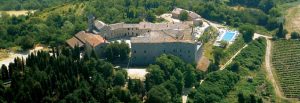
Titignano agriturismo
Titingnano’s castle was built by a family with French origins in 937 AD. In 1830 a Florence prince bought it at an auction from a Pontifical State that had confiscated it as part of the century-long medieval conflict between what we would today think of as political parties: the Guelphs, and the Ghibellines.
Orvieto was a Guelph enclave since the city was largely mercantile families, loyal to the pope over the emperor. Nearby Todi is next on our agenda and in contrast to Orvieto, comprised of wealthy landholders. This is why Todi was Ghibelline, and feared enlargement of the Papal States.
The strong afternoon light glints off the lake’s surface and makes me want to lie down for an afternoon siesta, and it appears that others feel the same. Or maybe it was the delicious meal in Orvieto. Okay, maybe it’s not the sun or the meal. We’ve been going at it pretty hard for the last week.
Todi
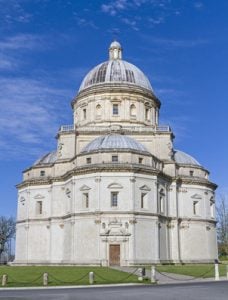
Santa Maria Della Consolazione in Todi
On the outskirts of Todi sits Santa Maria Della Consolazione, a refreshingly simply Renaissance church that I fell in love with after the Gothic overload of Siena and Orvieto architecture.
Overlooking the east bank of the Tiber, Todi was held up as the model of a sustainable city by Richard S. Levine, a professor of architecture at the University of Kentucky. Enrico tells us that Americans are beginning to move there for their retirement.
In the piazza that bears his name stands a statue of Giuseppe Garibaldi, whom I’m embarrassed to admit that I didn’t know until that afternoon. I ask Enrico about him and he tells me that Garibaldi was a central figure in the 19th Century movement for Italian unification.
Enrico is obviously proud of Garibaldi, whose successful military campaigns in both Latin America and Europe made him the “hero of two worlds.” Roberto Rossellini directed a film about him in 1961 and claimed it was the one of which he was most proud. It’s on my watchlist.
- Our tour group in Todi’s Piazza del Popolo
- Giuseppe Garibaldi statue in Todi, Italy
Fascinating factoid: Garibaldi was instrumental in President Lincoln’s Emancipation Proclamation; details in the video below.
Exiting Todi requires a ride down a narrow via with a near-vertical drop. Stairs had to be cut into the pavement for pedestrians. Enrico wisely leads us on our way instead of cautioning us in advance. After all the road presented us with no real danger and after a day of riding our tires are hot enough to stick. Later, we will laugh nervously trying to imagine that little via on a snowy or rainy day. Whew.
When we arrive at Altarocca, we spend a couple of hours as a group laughing and talking in the warm waters of its spa. We have truly come to enjoy each other’s’ company and begin talking about rallies in coming year where we might rendezvous.
In the morning, we’re for Rome.
I’ll tell you more stories from Italy this year, since I’m returning to ride my motorcycle through Tuscany, Corsica, and Sardinia in 2017. Subscribe using the purple button above and you’ll never miss an installment of the story.
Here is the beginning of the series. The next installment is a surprise stop in Civita Castellana to ooh and ahh over a vintage motorcycle collection.
